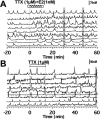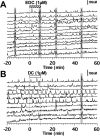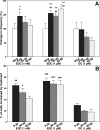Rapid action of estrogens on intracellular calcium oscillations in primate luteinizing hormone-releasing hormone-1 neurons
- PMID: 18079199
- PMCID: PMC2274903
- DOI: 10.1210/en.2007-0942
Rapid action of estrogens on intracellular calcium oscillations in primate luteinizing hormone-releasing hormone-1 neurons
Abstract
Feedback controls of estrogen in LHRH-1 neurons play a pivotal role in reproductive function. However, the mechanism of estrogen action in LHRH-1 neurons is still unclear. In the present study, the effect of estrogens on intracellular calcium ([Ca(2+)](i)) oscillations in primate LHRH-1 neurons was examined. Application of 17beta-estradiol (E(2), 1 nm) for 10 min increased the frequency of [Ca(2+)](i) oscillations within a few minutes. E(2) also increased the frequency of [Ca(2+)](i) synchronization among LHRH-1 neurons. Similar E(2) effects on the frequency of [Ca(2+)](i) oscillations were observed under the presence of tetrodotoxin, indicating that estrogen appears to cause direct action on LHRH-1 neurons. Moreover, application of a nuclear membrane-impermeable estrogen dendrimer conjugate, not control dendrimer, resulted in a robust increase in the frequencies of [Ca(2+)](i) oscillations and synchronizations, indicating that effects estrogens on [Ca(2+)](i) oscillations and their synchronizations do not require their entry into the cell nucleus. Exposure of cells to E(2) in the presence of the estrogen receptor antagonist ICI 182,780 did not change the E(2)-induced increase in the frequency of [Ca(2+)](i) oscillations or the E(2)-induced increase in the synchronization frequency. Collectively, estrogens induce rapid, direct stimulatory actions through receptors located in the cell membrane/cytoplasm of primate LHRH-1 neurons, and this action of estrogens is mediated by an ICI 182,780-insensitive mechanism yet to be identified.
Figures








Comment in
-
Unique estrogenic mechanisms for unique gonadotropin-releasing hormone neurons?Endocrinology. 2008 Nov;149(11):5325-7. doi: 10.1210/en.2008-1231. Endocrinology. 2008. PMID: 18936493 Free PMC article. No abstract available.
Similar articles
-
Involvement of G protein-coupled receptor 30 (GPR30) in rapid action of estrogen in primate LHRH neurons.Mol Endocrinol. 2009 Mar;23(3):349-59. doi: 10.1210/me.2008-0299. Epub 2009 Jan 8. Mol Endocrinol. 2009. PMID: 19131510 Free PMC article.
-
Firing pattern and rapid modulation of activity by estrogen in primate luteinizing hormone releasing hormone-1 neurons.Endocrinology. 2005 Oct;146(10):4312-20. doi: 10.1210/en.2005-0435. Epub 2005 Jun 23. Endocrinology. 2005. PMID: 15976055 Free PMC article.
-
Rapid action of oestrogen in luteinising hormone-releasing hormone neurones: the role of GPR30.J Neuroendocrinol. 2009 Mar;21(4):316-21. doi: 10.1111/j.1365-2826.2009.01839.x. J Neuroendocrinol. 2009. PMID: 19207808 Free PMC article. Review.
-
Rapid action of estradiol in primate GnRH neurons: the role of estrogen receptor alpha and estrogen receptor beta.Steroids. 2011 Aug;76(9):861-6. doi: 10.1016/j.steroids.2011.02.019. Epub 2011 Feb 25. Steroids. 2011. PMID: 21354432 Free PMC article.
-
Control of luteinizing hormone-releasing hormone pulse generation in nonhuman primates.Cell Mol Neurobiol. 1995 Feb;15(1):141-64. doi: 10.1007/BF02069563. Cell Mol Neurobiol. 1995. PMID: 7648606 Free PMC article. Review.
Cited by
-
Estrogen receptor beta-selective agonists stimulate calcium oscillations in human and mouse embryonic stem cell-derived neurons.PLoS One. 2010 Jul 27;5(7):e11791. doi: 10.1371/journal.pone.0011791. PLoS One. 2010. PMID: 20668547 Free PMC article.
-
Corticosteroids: way upstream.Mol Brain. 2010 Jan 11;3:2. doi: 10.1186/1756-6606-3-2. Mol Brain. 2010. PMID: 20180948 Free PMC article. Review.
-
Voltage-gated potassium currents are targets of diurnal changes in estradiol feedback regulation and kisspeptin action on gonadotropin-releasing hormone neurons in mice.Biol Reprod. 2011 Nov;85(5):987-95. doi: 10.1095/biolreprod.111.093492. Epub 2011 Jul 20. Biol Reprod. 2011. PMID: 21778142 Free PMC article.
-
Neuroestradiol in regulation of GnRH release.Horm Behav. 2018 Aug;104:138-145. doi: 10.1016/j.yhbeh.2018.04.003. Epub 2018 Apr 19. Horm Behav. 2018. PMID: 29626484 Free PMC article. Review.
-
Estradiol signaling in the regulation of reproduction and energy balance.Front Neuroendocrinol. 2012 Oct;33(4):342-63. doi: 10.1016/j.yfrne.2012.08.004. Epub 2012 Sep 7. Front Neuroendocrinol. 2012. PMID: 22981653 Free PMC article. Review.
References
-
- Shivers BD, Harlan RE, Morrell JI, Pfaff DW 1983 Absence of oestradiol concentration in cell nuclei of LHRH-immunoreactive neurones. Nature 304:345–347 - PubMed
-
- Lehman MN, Karsch FJ 1993 Do gonadotropin-releasing hormone, tyrosine hydroxylase-, and β-endorphin-immunoreactive neurons contain estrogen receptors? A double-label immunocytochemical study in the Suffolk ewe. Endocrinology 133:887–895 - PubMed
-
- Herbison AE, Horvath TL, Naftolin F, Leranth C 1995 Distribution of estrogen receptor-immunoreactive cells in monkey hypothalamus: relationship to neurones containing luteinizing hormone-releasing hormone and tyrosine hydroxylase. Neuroendocrinology 61:1–10 - PubMed
-
- Herbison AE 1998 Multimodal influence of estrogen upon gonadotropin-releasing hormone neurons. Endocr Rev 19:302–330 - PubMed
-
- Roy D, Angelini NL, Belsham DD 1999 Estrogen directly respresses gonadotropin-releasing hormone (GnRH) gene expression in estrogen receptor-α (ERα)- and ERβ-expressing GT1–7 GnRH neurons. Endocrinology 140:5045–5053 - PubMed
Publication types
MeSH terms
Substances
Grants and funding
LinkOut - more resources
Full Text Sources
Miscellaneous

